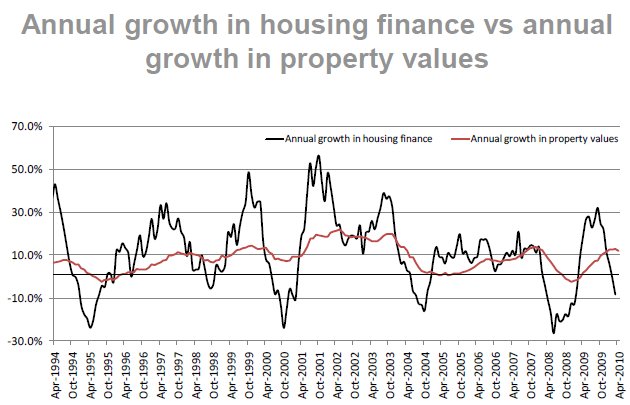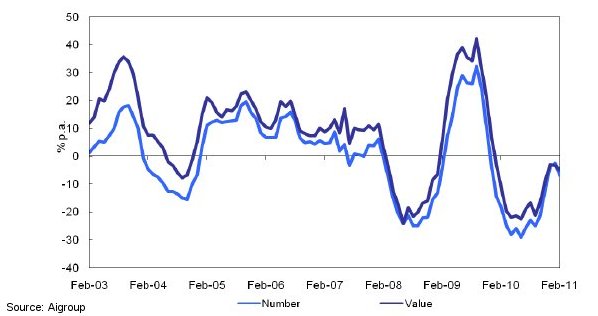WA’s property market has fallen into the worst slump in nearly two decades, the latest government figures reveal.
Activity in the housing market has fallen 15 per cent in just 12 months and more than one-third since the height of the boom in 2005-06, according to Landgate, the government’s official land information authority.
The depressing news follows data revealing Perth median house and unit prices fell for the third consecutive quarter during the three months to March and show no sign of stabilising.
Australian Property Monitors – owned by Fairfax Digital, publisher of this website – expects Perth property prices to continue to fall for the rest of the year in what could be the city’s worst property recession since before the Global Financial Crisis. Landgate chief executive Mike Bradford warned the state was on track to record the lowest number of property transactions since the early 1990s.
Home sales and transfers during the first half of 2010-11 were the lowest in a decade and had continued to plunge this year, with figures in January and February the lowest in nearly 20 years and March the worst in 14 years. The latest figures show the number of new mortgages in WA decreased by 23.7 per cent in the year to April. However, at the same time the number of new developments, including subdivisions and apartment blocks, significantly increased in response to an undersupply of properties last year
I submit that there was never an undersupply of housing, and just like Melbourne, the slow response of the housing market has now led the market into oversupply which will continue to get worse as those new houses/units are completed. As I have talked about many times before, sustained falling transaction volumes lead to falling prices with a lag of approximately 6 to 8 months. I first mentioned this in June last year where I presented this chart.
And here is the latest Annual growth in housing finance chart as at February. You can see that the rate of growth in credit has now been negative for over 12 months.
Transactions in WA are now at level not seen since before a decade of large credit expansion that has lead to very large increases in house prices. It is also worth noting that the number of houses on the market are now 75% higher then this time last year but more worryingly that figure is currently growing at 4.6% per month.
I note however that the WA housing minister seems to be completely oblivious to the issue, and is busy warning of the next impending boom.
The median house price in WA could eclipse $850,000 if land supplies shorten like they did during the last housing boom, Housing Minister Troy Buswell says. Speaking at the Australian Property Institute state conference yesterday, Mr Buswell said Perth had to avoid the kind of quick appreciation of property that occurred between 2004 and 2006, when the median house price jumped from $260,000 to $460,000.
“In two years, the Perth median house price went up by about 78 per cent and the reason it went up was in large part because we ran out of land and the price of land drove up the price of housing,” he said. “If, as our state’s economy continues to grow, we run out of land again and in a two-year period our median house price goes up by 80 per cent, the Perth median house price would be $850,000-plus.
“It is hard to live in WA now. If we go through the same property price bubble we went through in 2004-2006, at $850,000 we would have a lot of challenges in WA, both social and economic.”
Once again, a complete disregard for massive credit growth over the past decade that has now stalled, or the changes that demographics will bring in the next. But not to be outdone by his housing minister the WA Premier added his own little sprinkle of ignorance and delusion to the mix.
Perth’s first-home buyers have hit back at comments made by Premier Colin Barnett yesterday that they should lower their expectations if they ever want to realise their dream of owning a property. Mr Barnett said while he encouraged first-home buyers to enter the market, he said they were being unrealistic about what they wanted.
“I don’t want to hark back to the past, but in previous times couples, single people would often be content with buying a flat or an old house and doing it up,” Mr Barnett said.
“Now there seems to be an expectation amongst many, if not all, first-home owners to buy a brand new four bed, two bathroom home.
“Be realistic about your expectations and be prepared to buy a fairly humble property first off and gradually work your way up as you go through life and your income increases.
“(These expectations) are beyond what we normally associate with a young couple buying their first property.”
Mr Barnett admitted it was difficult for some people to get into the property market and said he paid $33,000 “back in the dark ages” for his first property in Lathlain Park.
Anyone who has been reading MacroBusiness for any length of time will realise how ridiculous Mr Barnett’s words are. The Unconventional Economist has written previously about the folly of comparing past and current affordability and claiming they are equal. But MacroBusiness is certainly not alone in our assessment of this point.
Colin Barnett was a senior economics tutor at the WA Institute of Technology when, in 1976, he and his then-wife upped stumps from their rented home in Melville to buy their first house on Goddard Street, Lathlain. Land titles records reveal the Barnetts paid $31,000, plus $440 stamp duty, for the modest 1950s-style brick-and-tile house on an 820sqm block not far from the Lathlain Park WAFL ground.
As a senior tutor, Mr Barnett was certainly taking home less than the average annual wage of $10,062, but he was still earning enough – his ex-wife’s occupation is listed on the title documents as “married woman” – to get a $26,000 loan from the R&I Bank. The Reserve Bank’s inflation calculator, which adjusts prices in line with the consumer price index to allow comparisons over time, reveals that the Premier’s first home, including stamp duty, cost $176,099 in 2011 dollars.
This compares to the $391,000 the house’s current occupants paid for it in 2005 – it appears to have been recently renovated – and the $631,000 median house price for Lathlain as a whole. The calculation is a stark illustration of the rampant house price inflation in the Perth market that is at the root of the city’s affordability problem.
Put the 1976 average wage of $10,062 through the same calculation and you find it is worth $53,478 in 2010 dollars. The Australian Bureau of Statistics puts today’s average annual wage at $66,170, showing that wages have grown quicker than inflation, so the average worker has more spending power today than they had 35 years ago.
But the price of housing has grown vastly more quickly and West Australians now spend a greater chunk of their income on housing than ever before. Mr Barnett, who paid $440,000 for his current home in Wilson Street, Claremont in 1997, would be acutely aware of that. The median house price in Claremont now is $1.25 million.
It seems to me that Western Australian is now at the forefront of the housing market slide, which is being led by the dynamics of debt saturation and boomer demographics. The government’s response suggests one of only two conclusions. The WA government is living in a lah lah land of delusion and ignorance. Or, it understands what is happening is embarking on a perverse reversal of RBA “open-mouth operations” in which it is trying to bully first home buyers into saving over-leveraged speculators.
Perhaps preparing the economy for the bust might be more useful.

